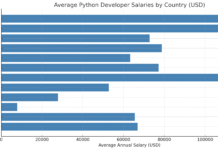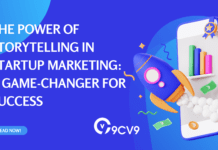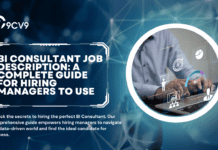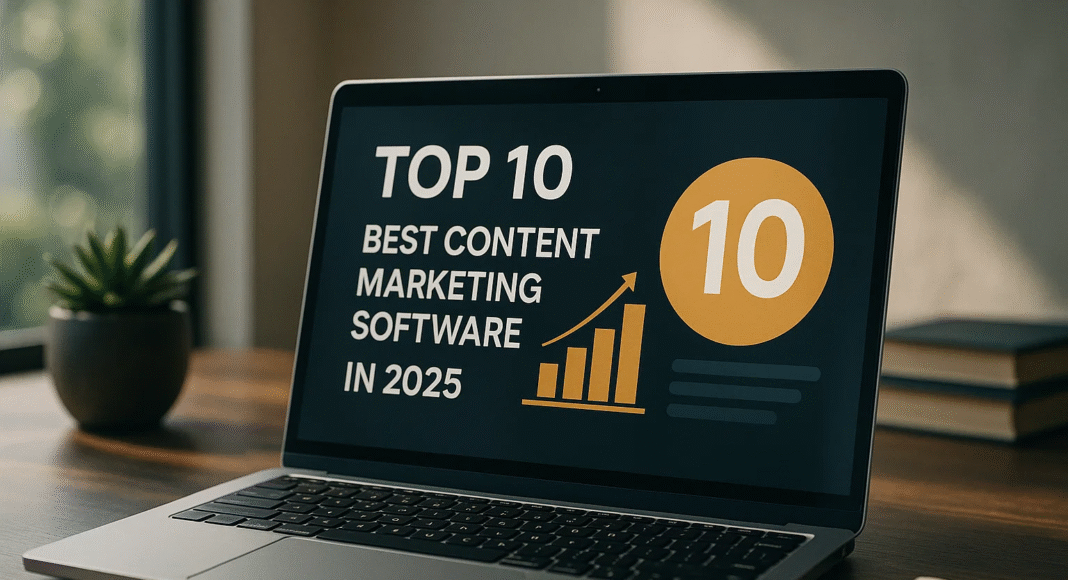Key Takeaways
- Discover the top 10 content marketing software platforms in 2025 that enhance content creation, SEO, and campaign automation.
- Learn how each tool supports different business sizes, from startups to enterprises, with features like AI, analytics, and workflow management.
- Find the ideal content marketing software to boost engagement, improve ROI, and streamline multi-channel strategies in today’s digital landscape.
In today’s hyper-competitive digital landscape, content marketing has become more than just a buzzword—it’s a strategic cornerstone of business growth, customer engagement, and brand authority. As we move through 2025, the demand for high-quality, data-driven, and automated content has skyrocketed across industries. Businesses—ranging from startups and eCommerce brands to enterprise-level corporations—are now investing heavily in content marketing software to streamline workflows, personalize audience engagement, and deliver measurable ROI.

The evolution of content marketing software in 2025 reflects a major shift in how companies approach content creation, distribution, performance analytics, and campaign optimization. With artificial intelligence (AI), machine learning (ML), predictive analytics, and automation tools deeply embedded into modern platforms, marketers are now equipped with unprecedented capabilities to craft smarter strategies. From AI-powered content generation and SEO optimization to omnichannel distribution and performance tracking, today’s content marketing tools are designed to reduce manual efforts and drive targeted results.
However, choosing the right content marketing software in 2025 is far from straightforward. The market is saturated with platforms offering overlapping features, yet not all tools cater equally to the specific needs of different businesses. Whether you’re a content strategist seeking better workflow automation, a digital marketer looking to improve audience targeting, or a small business owner aiming to maximize reach with limited resources, the right software can make a significant difference. Understanding which platforms lead the industry, and why, is essential for making an informed decision.
In this comprehensive guide, we explore the Top 10 Best Content Marketing Software in 2025—carefully selected based on functionality, innovation, ease of use, scalability, customer support, and overall impact on content strategy success. We delve into each tool’s unique features, strengths, ideal use cases, and pricing, helping you determine which platform aligns best with your business goals. Whether your focus is blog content, video marketing, social media, email campaigns, or a holistic omnichannel approach, this list covers solutions that empower you to stay ahead in a fast-changing digital environment.
By the end of this article, you’ll not only have a clear understanding of the best tools available in 2025 but also gain strategic insights into how these platforms can transform your content marketing efforts—turning content into a powerful engine for visibility, engagement, and conversion. Let’s dive into the most impactful content marketing software shaping the future of digital marketing this year.
Before we venture further into this article, we would like to share who we are and what we do.
About 9cv9
9cv9 is a business tech startup based in Singapore and Asia, with a strong presence all over the world.
With over nine years of startup and business experience, and being highly involved in connecting with thousands of companies and startups, the 9cv9 team has listed some important learning points in this overview of the Top 10 Best Content Marketing Software in 2025.
If your company needs recruitment and headhunting services to hire top-quality employees, you can use 9cv9 headhunting and recruitment services to hire top talents and candidates. Find out more here, or send over an email to [email protected].
Or just post 1 free job posting here at 9cv9 Hiring Portal in under 10 minutes.
Top 10 Best Content Marketing Software in 2025
- HubSpot Content Hub
- Semrush
- Ahrefs
- Canva
- CoSchedule Marketing Suite
- BuzzSumo
- Optimizely Content Marketing Platform
- Adobe Experience Manager (AEM)
- Storyteq
- Sprinklr Marketing
1. HubSpot Content Hub

The HubSpot Content Hub continues to dominate the content marketing landscape in 2025 as one of the most comprehensive and strategically integrated platforms available. Recognized for its seamless fusion of content creation, customer relationship management (CRM), sales automation, and analytics, HubSpot offers a robust solution tailored to the evolving needs of digital-first organizations.
Its exceptional performance across multiple marketing disciplines makes it a key entry in the Top 10 Best Content Marketing Software in 2025, particularly for businesses seeking an all-in-one solution with proven scalability and effectiveness.
Why HubSpot Content Hub Stands Out in 2025
1. End-to-End Content Marketing Automation
- All-in-One Platform: Combines CMS, blog management, SEO tools, marketing automation, social scheduling, email workflows, and lead tracking in a single interface.
- Centralized Customer Journey Mapping: Integrates content with CRM and sales pipelines for a full-funnel approach.
- AI-Powered Content Generation: Supports idea generation and SEO-friendly writing, reducing content production timelines.
- Dynamic Personalization: Delivers tailored content experiences based on user behaviors, lifecycle stages, and preferences.
2. Seamless Integration with the HubSpot Ecosystem
- CRM Integration: Natively connects with HubSpot’s free CRM, enabling precise content targeting and performance measurement.
- Cross-Functional Compatibility: Easily integrates with other tools including email, chatbots, advertising modules, and external apps like Salesforce, Shopify, and Slack.
- Unified Analytics Dashboard: Real-time reporting across channels—from content performance to conversion analytics.
3. Target Market and Scalability
- Ideal For:
- Small to medium-sized businesses (SMBs)
- Marketing agencies
- Growth-stage enterprises
- Use Case Flexibility: Suitable for both inbound marketing campaigns and full-scale demand generation strategies.
- Scalable Pricing: Ranges from free tiers for startups to enterprise packages exceeding $1,500/month for global teams.
4. Key Performance Metrics (2024–2025)
| Metric | Value |
|---|---|
| User Rating on G2 | 4.4 to 4.5 (based on 1,700+ reviews) |
| Market Share in CRM Sector | 35% (as of July 2024) |
| Customer Growth Rate (YoY) | 19% increase |
| Lead Generation Impact | Up to 107% increase in 6 months (based on case studies) |
| Notable Benefits Cited by Users | Ease of use, integration, SEO automation, landing page builder |
Feature Matrix: HubSpot Content Hub vs. Other Leading Platforms
| Feature Category | HubSpot Content Hub | Competitor A | Competitor B |
|---|---|---|---|
| CRM Integration | Native | Limited | External only |
| AI Content Tools | Included | Add-on | Not available |
| SEO Recommendations | Real-time, built-in | Manual | Basic |
| Workflow Automation | Advanced | Intermediate | Basic |
| Pricing Flexibility | Free to Enterprise | Mid-tier only | Enterprise only |
| Customer Journey Mapping | Comprehensive | Partial | Manual setup |
User Insights and Feedback in 2025
What Users Love:
- User-Friendly Interface: Intuitive dashboard suited for marketers without technical backgrounds.
- Integrated Marketing Stack: Everything from blogs and emails to forms and CTAs can be managed under one roof.
- Analytics-Driven Campaigns: Real-time insights on content ROI, traffic sources, and lead generation metrics.
Cited Limitations:
- Customization Constraints: Advanced users may find limitations in design flexibility compared to open-source CMS platforms.
- Cost Scaling: Premium features such as advanced reporting, A/B testing, and multi-language support may increase total costs significantly for large teams.
Real-World Impact: Case Study Summary
Case Study: SaaS Business in North America
- Problem: Fragmented content strategy with disconnected CRM and lead generation tools.
- Solution: Full migration to HubSpot Content Hub.
- Results:
- 107% increase in leads within six months.
- 68% improvement in content engagement rates.
- 22% reduction in sales cycle time.
- Increased fan engagement across LinkedIn and email channels.
Conclusion: Why HubSpot Content Hub is Among the Best Content Marketing Software in 2025
HubSpot Content Hub’s strength lies in its ability to unify marketing, sales, and service into a cohesive system that prioritizes content as the nucleus of customer acquisition and retention. With powerful features tailored for automation, SEO optimization, and performance analytics, it remains a compelling choice for organizations looking to modernize their digital strategy.
Its consistent growth trajectory, strong user satisfaction ratings, and performance-backed case studies justify its place among the Top 10 Content Marketing Platforms in 2025. Businesses prioritizing streamlined workflows, integrated analytics, and scalable growth should consider HubSpot not just as a tool—but as a foundational platform for long-term marketing success.
2. Semrush

In the highly competitive landscape of digital marketing, Semrush has emerged as one of the most indispensable platforms for SEO-focused content marketing. With over a decade of innovation and refinement, it now offers one of the most comprehensive toolkits in the industry, catering to businesses aiming for high-performance, organic visibility and content optimization. Its advanced capabilities in keyword intelligence, competitive benchmarking, content ideation, and SERP tracking distinguish it as a premier choice among marketing professionals in 2025.
Why Semrush is Among the Top 10 Content Marketing Software in 2025
1. A Full-Spectrum SEO and Content Intelligence Suite
Semrush’s core value lies in its ability to merge SEO fundamentals with content marketing strategies in a deeply integrated, data-rich environment:
- Advanced Keyword Research:
- Tracks millions of keywords across regions and languages.
- Provides keyword difficulty scoring, CPC trends, and intent categorization.
- Topic Research & SEO Writing Assistant:
- Generates topic clusters based on trending data and competitor coverage.
- Real-time SEO writing suggestions based on readability, tone of voice, and keyword density.
- On-Page SEO & Site Health Monitoring:
- Automated site audits identify structural, content, and performance issues.
- Provides actionable recommendations for technical and content-level fixes.
- Competitive Intelligence:
- Benchmarks against industry competitors.
- Visualizes keyword gaps, traffic sources, and backlink profiles.
- Content Gap Analysis:
- Identifies missing keyword opportunities across owned and competitor content.
Target Audience and Strategic Use Cases
Semrush’s multi-tiered functionality caters to an extensive user base in 2025:
- Ideal For:
- SEO specialists and digital marketing consultants
- In-house content strategists
- Marketing agencies and enterprise teams
- E-commerce and SaaS businesses focused on inbound traffic
- Strategic Applications:
- Pre-launch keyword planning for product pages
- Competitive landscape analysis for blog campaigns
- SERP feature targeting (snippets, People Also Ask, etc.)
- Content auditing and update strategies for evergreen assets
Performance Benchmarks and Industry Validation (2024–2025)
| Performance Metric | Value |
|---|---|
| Average User Rating (G2) | 4.5 – 4.6 (2,500+ reviews) |
| Market Share (SEO/SEM Tools) | 22.94% |
| Pro Plan Pricing | $139.95/month |
| Notable Case Study (American Eagle) | 258% increase in organic traffic |
| Year-over-Year Customer Growth | 18% growth between 2023 and 2024 |
| Countries Supported | 150+ (multilingual SEO capabilities) |
Feature Matrix: Semrush vs. Leading SEO-Content Platforms
| Feature Set | Semrush | Competitor A | Competitor B |
|---|---|---|---|
| Keyword Intelligence | Global & local data | Regional only | Limited depth |
| Competitive Analysis | Deep and visualized | Surface-level | Manual comparison |
| Content Optimization Assistant | Built-in with AI | Requires add-on | Not available |
| Backlink Tracking & Auditing | Yes, with historical data | No | Basic only |
| SERP Position Tracking | Daily, with alerts | Weekly only | Lacks real-time view |
| Pricing Flexibility | Tiered subscriptions | Premium-only | Fixed plans |
User Reviews and Industry Feedback
Positive Sentiments:
- Comprehensive & Professional:
- Professionals praise Semrush for being an all-in-one platform that eliminates the need for multiple SEO tools.
- Insight-Driven Reporting:
- Real-time performance dashboards offer actionable insights for both strategic planning and daily operations.
- Content Marketing Toolkit:
- Tools like the SEO Writing Assistant and Topic Research are essential for editorial planning and optimization.
Common Challenges Noted:
- Learning Curve:
- The platform’s extensive feature set may overwhelm beginners without formal SEO training.
- Pricing Concerns:
- More advanced features and usage quotas (e.g., for reporting or keyword tracking) are locked behind higher-tier plans.
Real-World Success Snapshot
Case Study: American Eagle Outfitters
- Challenge: Low organic visibility across high-converting apparel keywords.
- Solution: Full-scale Semrush implementation including keyword mapping, topic cluster strategy, and backlink audits.
- Results:
- 258% organic traffic growth within 12 months.
- 31% increase in first-page rankings.
- 70% improvement in content engagement metrics (CTR, average session duration).
Conclusion: Semrush’s Strategic Relevance in 2025
Semrush continues to prove itself as a mission-critical tool for modern content marketing, especially in a digital era dominated by search-driven behavior. Its rich feature set, exceptional data accuracy, and strategic insights make it one of the most powerful platforms for SEO-aligned content development and performance monitoring in 2025.
For businesses that treat content as a measurable asset, not just a marketing tactic, Semrush provides the analytical depth, technical strength, and content optimization intelligence required to outperform the competition—cementing its place among the Top 10 Best Content Marketing Software in 2025.
3. Ahrefs

As the demand for data-informed content marketing intensifies in 2025, Ahrefs remains a cornerstone solution for professionals seeking granular control over search engine visibility, backlink profiling, and competitive SEO benchmarking. Renowned for its massive crawling infrastructure and unparalleled database of live links, Ahrefs offers a meticulously engineered SEO toolkit that empowers businesses to uncover growth opportunities, refine on-page performance, and outrank competitors through intelligent content strategies.
Positioned as one of the Top 10 Best Content Marketing Software in 2025, Ahrefs caters to enterprises, agencies, and SEO-focused marketers aiming to lead organic search in highly competitive digital ecosystems.
Why Ahrefs Continues to Lead the SEO Content Marketing Space in 2025
1. Unmatched Backlink Intelligence and Web Crawling Capabilities
- Industry-Leading Web Crawler:
- Ahrefs boasts one of the largest web crawlers in the world (second only to Google), indexing billions of pages daily.
- Provides up-to-date, high-accuracy backlink data critical for technical audits and link-building strategies.
- Backlink Audit and Discovery:
- Identifies broken links, toxic backlinks, and referring domains.
- Pinpoints anchor text distribution and link growth velocity.
- Domain Comparison & Link Intersect:
- Compares backlink profiles of multiple domains to find untapped opportunities.
- Analyzes competitor link-building trends.
2. Comprehensive Keyword & Content Explorer Tools
- Keywords Explorer:
- Accesses over 10.2 billion keywords across 171 countries and multiple search engines including Google, YouTube, Amazon, Bing, and Baidu.
- Delivers keyword difficulty scores, click potential, search intent categorization, and SERP analysis.
- Content Explorer:
- Enables real-time discovery of top-performing content by topic, backlinks, traffic, and social shares.
- Ideal for trend analysis and ideating data-backed editorial calendars.
- Traffic Potential Modeling:
- Predicts the potential organic traffic of entire keyword clusters—not just individual keywords.
3. SEO Site Health Optimization
- Site Audit Tool:
- Scans for over 140 technical SEO issues, including JavaScript rendering, indexability, mobile-friendliness, speed, and crawl budget optimization.
- Prioritizes fixes by severity and impact on rankings.
- Rank Tracker:
- Tracks keyword rankings across devices and locations with competitor benchmarking features.
Ideal Use Cases and Target Demographics
Ahrefs’ toolset supports high-precision SEO content strategies across varying business needs:
- Target Users:
- SEO professionals and analysts
- Content marketing teams
- Digital marketing agencies
- Enterprise e-commerce and SaaS platforms
- Primary Use Cases:
- Backlink intelligence and outreach planning
- Content gap identification and keyword targeting
- Site audits and on-page SEO compliance
- Competitor reverse engineering
Performance Metrics & Industry Adoption (2024–2025)
| Metric | Value |
|---|---|
| Global User Rating (G2) | 4.5 to 4.7 stars (500+ verified reviews) |
| Market Share (SEO/SEM Segment) | 22.94% |
| Entry-Level Pricing (Lite Plan) | $129/month |
| Number of Keywords in Database | 10.2+ billion |
| Number of Countries Supported | 170+ |
| Crawl Depth | 8+ billion pages indexed per day |
| Notable Use Case | 300% traffic growth via backlink optimization |
Feature Matrix: Ahrefs vs. SEO-Content Marketing Competitors (2025)
| Feature/Capability | Ahrefs | Semrush | Moz Pro |
|---|---|---|---|
| Web Crawler Size | Largest (non-Google) | Medium | Smaller |
| Backlink Index | Real-time | Periodic | Basic |
| Keyword Database | 10.2B+ | 25B+ | 500M+ |
| Site Audit Tools | Technical + UX | Technical | Technical |
| SERP History Archive | Yes | Yes | No |
| Pricing Entry Point | $129/month | $139.95/month | $99/month |
| SEO Writing Assistant | No (3rd party) | Included | Basic |
User Sentiment and Platform Feedback in 2025
Strengths Highlighted by Users:
- Superior Backlink Data:
- Most reliable source for backlink research and competitive link audits.
- Precision Keyword Metrics:
- Accurate keyword volume, clicks, and CTR insights lead to stronger campaign targeting.
- Content Discovery & Gap Analysis:
- Enables users to identify underexploited keyword themes and high-performing competitors.
Limitations Identified:
- No Built-in Writing Assistant:
- Lacks native content creation tools; integration with external platforms is necessary for full editorial execution.
- Credit-Based Pricing:
- Lite and Standard plans include limited monthly query credits, which may restrict usage for large-scale operations.
- Higher Cost for Full Features:
- Advanced features like historical SERP data, link intersect, and API access are only available in higher-tier plans.
Real-World Impact: Case Study Summary
Case Study: SaaS Firm Scaling Global Visibility
- Challenge: Poor international organic reach and low authority backlink profile.
- Implementation: Deployed Ahrefs for global keyword discovery, backlink building, and competitor tracking.
- Results:
- 300% increase in monthly organic traffic within 9 months.
- 2.4x increase in referring domains.
- Ranked in the top 3 for 18 targeted keywords in competitive SaaS categories.
Conclusion: Why Ahrefs is a Critical Asset in 2025’s Content Marketing Stack
In 2025, Ahrefs stands as a quintessential tool for content marketers and SEO professionals who demand data depth, competitive clarity, and backlink intelligence. While it may not offer in-app content writing features, its superior infrastructure for tracking, analyzing, and strategizing SEO-centric content campaigns solidifies its place among the Top 10 Best Content Marketing Software of 2025.
Its commitment to technical precision, real-time data accuracy, and unparalleled crawling capabilities make Ahrefs not just a tool—but a strategic platform for brands seeking to dominate organic search performance.
4. Canva

In 2025, visual content remains a cornerstone of digital marketing success. With the growing dominance of video snippets, infographics, branded imagery, and animated assets across platforms like Instagram, LinkedIn, YouTube, and TikTok, marketers are under pressure to produce visually compelling content quickly and consistently.
Canva emerges as the go-to solution, offering a scalable and accessible visual content platform that empowers teams—regardless of design experience—to generate professional-grade designs in minutes. Its intuitive interface, cloud-based architecture, and extensive template ecosystem position it as one of the Top 10 Best Content Marketing Software Platforms in 2025, particularly in the visual and branding segments.
Why Canva Is a Vital Asset for Modern Content Marketers
1. End-to-End Visual Design Ecosystem
Canva provides a suite of integrated features that enable marketers to go from ideation to execution with minimal friction:
- Drag-and-Drop Design Editor:
- Requires no prior graphic design experience.
- Allows users to create complex visuals with simple interactions.
- Extensive Template Library:
- Over 250,000 templates for various formats—social media, video, presentations, eBooks, ads, resumes, infographics.
- Brand Kit & Style Management:
- Maintain brand consistency by setting up brand colors, logos, and fonts across all team designs.
- Ideal for businesses managing multiple client brands or internal departments.
- Content Scheduling Integration:
- Allows direct publishing to platforms like Instagram, Facebook, LinkedIn, Pinterest, and TikTok via Canva’s built-in scheduler.
2. Scalability and Accessibility for All Business Types
- Designed for All Skill Levels:
- Enables beginners to create polished assets without any training.
- Offers advanced customization tools for experienced marketers and designers.
- Generous Free Tier:
- Provides access to thousands of templates, stock photos, and storage.
- Perfect for startups, freelancers, and solopreneurs.
- Enterprise Collaboration Tools:
- Shared folders, team templates, and permission controls for marketing departments and agencies.
- Enables brand-wide governance and real-time collaboration.
Key User Segments and Strategic Applications
| User Type | Primary Use Case |
|---|---|
| Small Business Owners | Social media graphics, promo videos, flyers |
| Marketing Teams | Branded campaigns, infographics, lead magnets |
| Content Creators & Influencers | Thumbnails, reels, animations, pitch decks |
| Educators & Nonprofits | Reports, presentations, educational visuals |
| Agencies & Design Studios | Client-based asset creation, multi-brand style management |
Performance Indicators & Industry Position (2024–2025)
| Performance Metric | Value |
|---|---|
| Average G2 User Rating | 4.7 out of 5 (based on 4,400+ reviews) |
| Monthly Active Users (MAUs) | 170 million+ globally |
| Market Share (Graphics Software) | 12.47% |
| Pro Plan Pricing | Starts at $14.99/month |
| Enterprise Plan | Custom pricing for advanced collaboration |
| Top Features Praised | Simplicity, template quality, time efficiency |
| Case Study Impact | Increased user engagement and brand adoption |
Canva vs. Other Visual Content Tools: Feature Comparison Matrix
| Feature/Capability | Canva | Adobe Express | Visme |
|---|---|---|---|
| Drag-and-Drop Interface | Yes | Yes | Yes |
| Template Library Size | 250,000+ | ~60,000 | ~50,000 |
| Brand Kit Features | Available (Pro+) | Limited | Available |
| Video Editing Capabilities | Yes (lightweight) | Basic | Intermediate |
| Social Media Scheduling | Built-in | No | No |
| Free Plan Offering | Yes (generous) | Yes | Yes |
| Ideal For | All skill levels | Beginners | Professionals |
User Sentiment and Platform Strengths in 2025
Key Strengths Reported by Users:
- Ease of Use:
- Frequently cited as the easiest visual design tool available.
- Reduces production time from hours to minutes, even for video content.
- Template & Asset Diversity:
- Highly adaptable to different industries and marketing formats.
- Brand Consistency at Scale:
- Essential for agencies and businesses managing multiple brand identities.
Constructive Criticism and Limitations:
- Limited Advanced Editing:
- May not satisfy experienced designers who require layered, pixel-level editing (compared to tools like Adobe Photoshop).
- Internet Dependency:
- As a cloud-based solution, Canva requires a stable internet connection for optimal functionality.
- Stock Asset Costs:
- Premium assets and templates may incur additional charges, even on Pro plans.
Canva in Action: Case Study Snapshot
Case Study: Marketing Department of a SaaS Company
- Challenge: Bottlenecks in visual content production due to reliance on in-house design team.
- Solution: Deployed Canva Pro for all non-design team members (content, sales, and marketing).
- Results:
- Reduced turnaround time for social campaigns by 70%.
- Increased branded content output by 3.5x within 6 months.
- Enhanced cross-team collaboration via shared folders and brand kits.
Conclusion: Canva’s Essential Role in Content Marketing Software Ecosystems in 2025
As visual communication continues to drive content consumption across platforms, Canva solidifies its position as a critical enabler of scalable, high-impact design for marketers. Its democratization of design, paired with intuitive tools and seamless team functionality, makes it indispensable for businesses prioritizing brand consistency, design agility, and speed-to-market in 2025.
Canva’s ability to empower entire marketing teams—not just designers—sets it apart as one of the Top 10 Best Content Marketing Software Platforms of the year. Whether for startups aiming to professionalize their brand or enterprises scaling design across teams, Canva delivers measurable value in every pixel.
5. CoSchedule Marketing Suite

As content marketing in 2025 grows increasingly complex—spanning blogs, social media, email, and cross-functional campaigns—marketers require more than just creation tools. They need systematic coordination, visibility, and accountability. This is where CoSchedule Marketing Suite positions itself as a game-changing solution.
CoSchedule is not just a content calendar—it’s a comprehensive marketing operations platform that enables teams to organize, plan, and execute campaigns from a centralized hub. With its intuitive interface, strategic automation, and workflow alignment features, CoSchedule empowers marketing departments, agencies, and editorial teams to increase output without sacrificing quality or timeline discipline.
Key Reasons CoSchedule Is Among the Top Content Marketing Platforms in 2025
1. Unified Marketing Calendar for Total Visibility
- Drag-and-Drop Calendar Interface:
- Centralizes all campaign activities into a single, visual timeline.
- Allows users to reschedule tasks, reassign responsibilities, and shift priorities instantly.
- Real-Time Project Tracking:
- Instantly see what content is in progress, delayed, or completed.
- Helps prevent bottlenecks by visualizing the entire team’s workload.
2. Workflow Automation and Task Management
- Task-Based Workflow Builder:
- Assign roles, set deadlines, and define approval hierarchies within recurring or custom templates.
- Cross-Functional Collaboration:
- Facilitates coordination between marketing, design, SEO, and social media teams.
- Enables internal checklists, dependencies, and asset attachments.
- Customizable Campaign Templates:
- Automate multi-step processes like product launches or blog production.
3. Social Media Publishing & Engagement Management
- Social Scheduler & Automation:
- Queue and publish posts across LinkedIn, Facebook, X (Twitter), Instagram, and Pinterest.
- Use “Best Time” publishing suggestions powered by engagement analytics.
- ReQueue Automation Tool:
- Recirculates evergreen content based on performance data to maximize exposure.
Ideal Users and Strategic Use Cases
| Target Audience | Primary Use Case |
|---|---|
| Marketing Departments | Integrated campaign planning and execution |
| Content Teams | Editorial calendar management and publication flow |
| Agencies | Client content scheduling and multi-account governance |
| Social Media Managers | Consistent scheduling, monitoring, and performance review |
| CMOs & Team Leads | Marketing visibility, accountability, and output tracking |
Performance Benchmarks & Industry Position (2024–2025)
| Metric | Value |
|---|---|
| User Rating (G2) | 4.3 to 4.4 out of 5 (150+ verified reviews) |
| Starting Price | $19/user/month (Social Calendar Plan) |
| Productivity Increase (Case Study) | 75% increase in project output (Evernest) |
| Social Engagement Boost | Reported uplift in engagement across 4+ platforms |
| Core Feature Category | Marketing calendar, automation, project management |
| Competitive Differentiator | End-to-end marketing ops visibility and alignment |
Feature Matrix: CoSchedule vs. Content Ops Competitors (2025)
| Feature | CoSchedule | Trello + Buffer Combo | Monday.com + Hootsuite |
|---|---|---|---|
| Centralized Calendar | Yes | No (separate tools) | Partial (integration required) |
| Built-In Social Scheduling | Yes | Requires Buffer | Requires Hootsuite |
| Workflow Automation Templates | Yes | Manual setup | Yes |
| Visual Task Progress Tracking | Yes | No | Yes |
| Cross-Channel Campaign Coordination | Full | Limited | Intermediate |
| Evergreen Post Re-Publishing | Yes (ReQueue) | No | No |
| Pricing Entry Point | $19/user/month | ~$20/month (combined) | $29+/user/month |
User Sentiment & Expert Feedback in 2025
Platform Strengths Noted by Users:
- Superior Organizational Capability:
- Consolidates disparate campaign elements into a cohesive workflow.
- Improved Team Accountability:
- Assignable tasks and real-time visibility encourage ownership and deadline adherence.
- Reduced Manual Workload:
- Templates, automation, and scheduling features drastically reduce manual effort.
Reported Limitations:
- Cost Sensitivity for Small Teams:
- Pricing may become a constraint for startups or small businesses managing many users.
- Customization Ceiling:
- Advanced customization (e.g., custom fields, logic-based task triggers) may not match enterprise-level tools.
Case Study Highlight: Evernest
Challenge:
Evernest, a property management firm, struggled with fragmented marketing execution across content, email, and social platforms.
Solution:
The team adopted CoSchedule’s Marketing Suite to consolidate calendars, automate workflows, and align team members with shared timelines.
Results:
- 75% increase in campaign volume over 6 months.
- Reduction in missed deadlines by 40%.
- Stronger brand consistency across all channels.
Conclusion: Why CoSchedule is a Strategic Marketing Command Center in 2025
In an era where cross-functional coordination and content velocity are as critical as creativity, CoSchedule Marketing Suite delivers on the foundational promise of marketing operations excellence. Its centralized calendar, built-in automation tools, and social publishing infrastructure allow teams to streamline campaign management, reduce miscommunication, and drive predictable results.
By enabling end-to-end visibility into project timelines and outputs, CoSchedule empowers marketers to operate with clarity, speed, and collaboration—justifying its recognition as one of the Top 10 Best Content Marketing Software Platforms in 2025.
6. BuzzSumo

As content saturation intensifies across digital platforms in 2025, successful marketers no longer rely on guesswork. Instead, they turn to BuzzSumo—a powerful, research-driven platform that helps organizations identify what content resonates, who influences conversations, and how competitors perform.
BuzzSumo’s real-time insights into social engagement, trending topics, and influencer reach position it as a mission-critical tool for marketers looking to develop timely, data-backed content strategies and maximize organic distribution across channels. It is especially favored by content strategists, PR professionals, and digital marketers aiming to stay ahead of emerging trends and capitalize on high-performing formats.
Key Reasons BuzzSumo Is Among the Top Content Marketing Software in 2025
1. Real-Time Content Discovery and Performance Insights
- Live Trend Monitoring:
- Identifies the most shared and engaged-with content in real time across major platforms (Facebook, X, LinkedIn, Pinterest).
- Tracks viral trends across industries, geographies, and timeframes.
- Content Analyzer Tool:
- Provides deep performance metrics—shares, engagements, backlinks, and content type breakdown—for any URL or keyword.
- Enables strategic benchmarking against competitors’ top-performing content.
- Alerts & Mentions:
- Notifies teams instantly about brand mentions, keywords, competitor activity, and trending topics—vital for PR and newsjacking.
2. Influencer Identification and Outreach Intelligence
- Influencer Search Engine:
- Identifies influential figures by niche, geography, or engagement metrics.
- Tracks follower count, domain authority, average shares, and engagement rate.
- Content Amplification Planning:
- Suggests outreach strategies based on influencer audience alignment and relevance.
- Ideal for earned media, influencer marketing, and partnership campaigns.
3. Competitor Strategy Analysis
- Competitive Content Audit:
- Reveals which types of competitor content attract the most links, shares, and reactions.
- Exposes publishing frequency, topic focus, and platform strength for rivals.
- Gap Analysis:
- Identifies untapped content opportunities in your niche by comparing gaps in topic coverage or engagement.
Who Uses BuzzSumo and Why It’s a Strategic Fit
| User Role | Strategic Use Case |
|---|---|
| Content Marketers | Trend identification, headline testing, format optimization |
| PR & Comms Teams | Brand monitoring, media mention alerts, journalist targeting |
| Social Media Managers | Viral content discovery, influencer identification, post timing |
| SEO Teams | Backlink tracking, content ideation based on engagement benchmarks |
| Market Researchers | Topic demand analysis, audience behavior mapping |
Platform Performance Benchmarks (2024–2025)
| Performance Metric | Value |
|---|---|
| Average User Rating (G2) | 4.5 to 4.6 out of 5 (100+ reviews) |
| Monthly Mentions Tracked | 8+ million across major digital channels |
| Influencer Profiles Indexed | Over 700,000 with full engagement metrics |
| Real-Time Alerts per User | Up to 1,000 (based on plan) |
| Pricing Entry Point | $199/month (Content Creation plan) |
| Supported Languages | 20+ |
| Customer Reported Benefits | Up to 3x increase in campaign reach |
Feature Comparison Matrix: BuzzSumo vs Competitor Platforms
| Feature Category | BuzzSumo | Brandwatch | Meltwater |
|---|---|---|---|
| Real-Time Content Discovery | Yes | Partial | Yes |
| Social Engagement Analytics | Yes (multi-platform) | Yes | Yes |
| Influencer Identification | Yes (in-platform) | Yes (via database) | Yes |
| Backlink & SEO Metrics | Integrated with Ahrefs | Requires integration | Yes (basic) |
| Custom Alerts | Fully customizable | Limited | Yes |
| Ease of Use | Highly intuitive | Enterprise-oriented | Intermediate |
| Pricing Flexibility | Mid-to-high tier | Enterprise pricing | Enterprise pricing |
User Feedback and Real-World Impact
Praised Capabilities:
- Trend-Driven Content Strategy:
- Marketers highlight BuzzSumo’s ability to surface content formats and headlines proven to engage target audiences.
- Data Visualization:
- Easy-to-interpret charts and timelines streamline content planning discussions.
- Influencer ROI Optimization:
- Enables targeted outreach by identifying influencers who generate real engagement, not just vanity metrics.
Commonly Reported Limitations:
- Premium Pricing Tier:
- While packed with functionality, entry costs may be high for startups or solopreneurs.
- Limited Customization in Lower Tiers:
- Some deeper filters and historical search capabilities are restricted to Pro and Plus plans.
Case Study Spotlight: Media Agency Content Expansion
Scenario:
A leading digital agency needed a reliable solution to guide its editorial team toward viral content formats and high-ROI influencer collaborations.
BuzzSumo Integration:
- Used BuzzSumo to identify trending topics and engagement formats within their client’s target niche.
- Deployed the Influencer Discovery feature to contact top amplifiers for outreach campaigns.
Results:
- Increased campaign engagement rates by 240%.
- Identified 15 new evergreen content formats that consistently outperformed prior benchmarks.
- Reduced time spent on content ideation by 60%.
Conclusion: BuzzSumo’s Strategic Value in the 2025 Content Marketing Stack
BuzzSumo continues to stand as a mission-critical research and performance intelligence platform in 2025. Its unparalleled ability to deliver real-time visibility into what content is working, combined with actionable insights into influencer impact and social performance metrics, makes it one of the most trusted tools for shaping proactive and competitive content strategies.
Whether for trend validation, audience engagement analysis, or identifying content amplification partners, BuzzSumo gives marketing teams the strategic foresight needed to outperform in a crowded digital arena—earning its place as one of the Top 10 Best Content Marketing Software Platforms of 2025.
7. Optimizely Content Marketing Platform

In the evolving landscape of digital marketing, content delivery is no longer a siloed process but a multi-dimensional, cross-channel operation that demands orchestration, collaboration, and performance visibility. At the forefront of this evolution is the Optimizely Content Marketing Platform (CMP)—formerly known as Welcome CMP—which has redefined how enterprise teams plan, produce, and optimize content at scale.
Designed specifically for large organizations and global marketing departments, Optimizely CMP offers a centralized hub for managing high-volume, high-complexity marketing campaigns that span across touchpoints. With its intelligent campaign workflows, AI-driven automation, and strategic analytics, Optimizely CMP is rightly recognized as one of the Top 10 Best Content Marketing Software Platforms of 2025.
Why Optimizely CMP Is a Premier Content Marketing Software in 2025
1. Enterprise-Grade Marketing Orchestration and Workflow Automation
- Centralized Campaign Planning:
- Visual planning boards align all stakeholders on objectives, timelines, deliverables, and KPIs.
- Supports global marketing teams by synchronizing cross-department efforts.
- Modular Workflow Management:
- Breaks down complex content processes into tasks and stages with real-time collaboration.
- Supports approval hierarchies, SLA tracking, and customizable workflow templates.
- Integrated Calendars & Timelines:
- Offers high-visibility editorial calendars for campaign roadmaps, resource allocation, and channel deployment.
2. Advanced Content Creation, Optimization, and AI Enablement
- AI-Enhanced Content Creation:
- Leverages machine learning to assist with idea generation, headline suggestions, tone analysis, and content scoring.
- Dynamic Content Personalization:
- Delivers content variants based on behavioral triggers, persona profiles, and A/B tested outcomes.
- Optimization Tools:
- Built-in SEO recommendations, readability scoring, and engagement metrics ensure content effectiveness before publication.
3. Robust Cross-Channel Publishing and Performance Analytics
- Multi-Channel Content Distribution:
- Enables seamless publishing across web, email, paid ads, and social platforms from one interface.
- Integrates with CMS platforms, CRM systems, and ad management tools for closed-loop marketing.
- Real-Time Analytics Dashboards:
- Offers deep insights into asset-level, campaign-level, and channel-level performance.
- Supports ROI modeling, funnel visualization, and heatmapping of content engagement.
Key User Segments and Strategic Use Cases
| User Type | Primary Use Case |
|---|---|
| Enterprise Marketing Teams | Planning and executing multi-region content strategies |
| Content Operations Managers | Workflow oversight, resource planning, and calendar management |
| Digital Campaign Strategists | Managing omnichannel content across web, social, and paid media |
| CMOs & Marketing Executives | Strategic alignment, analytics oversight, and performance forecasting |
| Creative Teams | Collaborative content production and optimization with review cycles |
Performance Indicators & Market Positioning (2024–2025)
| Metric | Value |
|---|---|
| Average User Rating (G2) | 4.3 out of 5 (80+ verified enterprise reviews) |
| Target Audience | Enterprises, global teams, marketing operations leaders |
| Pricing Estimate (Entry Point) | Starts at ~$36,000/year (customized quotes) |
| Deployment Model | Cloud-based SaaS with custom integrations |
| Key Performance Case Study | 48% faster time-to-publish; 30% improved collaboration efficiency |
| Integrations | CMS, CRM, DAM, and project management suites |
Capability Matrix: Optimizely CMP vs. Other Enterprise CMP Platforms
| Feature Category | Optimizely CMP | Adobe Workfront | Contently |
|---|---|---|---|
| Workflow Customization | Advanced | Intermediate | Basic |
| AI Content Suggestions | Yes | No | Limited |
| Multi-Channel Publishing | Fully Integrated | Partial | Partial |
| Cross-Team Collaboration | Real-Time | Asynchronous | Manual |
| Performance Reporting | Granular + Real-Time | Intermediate | Intermediate |
| Ideal Customer Size | Enterprise | Enterprise | Mid to Enterprise |
| Pricing Transparency | Quote-Based | Quote-Based | Quote-Based |
Real-World Impact: Enterprise Case Study Snapshot
Scenario:
A global B2B tech company operating across 15 markets faced fragmented content workflows, inconsistent brand messaging, and slow campaign rollout.
Optimizely CMP Implementation:
- Deployed a unified content calendar across 12 regions.
- Automated task assignments and approval chains for over 50 team members.
Results:
- 48% faster campaign deployment due to streamlined processes.
- 30% reduction in content production delays.
- Enhanced visibility into performance metrics at the asset and campaign levels.
User Sentiment and Platform Feedback in 2025
Strengths Commonly Highlighted by Users:
- Orchestration at Scale:
- Enables complex campaign alignment across departments, time zones, and digital channels.
- Content Lifecycle Automation:
- Reduces manual input and human error across content ideation, production, and distribution.
- Integrated Intelligence:
- AI and performance analytics make the platform proactive, not just reactive.
Reported Limitations:
- Steep Learning Curve:
- New users unfamiliar with enterprise marketing platforms may face onboarding challenges.
- High Entry Cost:
- Better suited for mid-to-large enterprises with mature content teams and larger budgets.
Conclusion: Optimizely CMP as the Strategic Nerve Center of Enterprise Marketing in 2025
With marketing complexity on the rise, Optimizely CMP emerges as a strategic command center for orchestrating content initiatives at scale. It goes far beyond basic content scheduling or publishing, empowering global teams to plan, align, execute, and analyze content across the entire customer journey with surgical precision.
Its focus on intelligent workflows, AI-enhanced content optimization, and comprehensive analytics makes it an invaluable platform for enterprise-grade content operations—justifying its place among the Top 10 Best Content Marketing Software Solutions in 2025.
8. Adobe Experience Manager (AEM)

As enterprises in 2025 strive to deliver hyper-personalized, omnichannel digital experiences at scale, few platforms rise to the challenge like Adobe Experience Manager (AEM). AEM stands out as a comprehensive content management and digital asset management solution, purpose-built to address the complex content orchestration demands of large organizations operating across global markets.
With its seamless integration into the broader Adobe Experience Cloud ecosystem, including Adobe Analytics, Adobe Target, and Adobe Creative Cloud, AEM delivers a unified marketing infrastructure that empowers enterprises to plan, execute, and optimize content strategies with unmatched precision.
Its deep-rooted capabilities in personalization, multi-channel delivery, and scalable content operations solidify its position as one of the Top 10 Best Content Marketing Software Platforms in 2025.
Key Reasons Adobe Experience Manager Is a Top-Tier Content Marketing Platform in 2025
1. Unified Content and Asset Management
- Headless and Hybrid CMS Architecture:
- Offers both traditional and headless CMS capabilities for flexibility across frontend frameworks.
- Enables real-time content updates across web, mobile, IoT, and in-store screens.
- Enterprise Digital Asset Management (DAM):
- Centralizes management of large volumes of high-resolution images, videos, PDFs, and creative files.
- Includes AI-powered tagging, metadata management, and rights governance for efficiency and compliance.
- Smart Content Automation:
- Automates content adaptation for multiple channels using AI (Adobe Sensei).
- Reduces manual duplication for creating regional or persona-specific variants.
2. Deep Adobe Ecosystem Integration
- Seamless Linkage with Adobe Creative Cloud:
- Designers and content teams collaborate in real-time with shared assets and version controls.
- Native integrations with Photoshop, Illustrator, and InDesign accelerate production timelines.
- Performance Intelligence with Adobe Analytics & Target:
- Connects A/B testing and user behavior analytics directly with content to inform optimization.
- Personalization engines adjust content in real time based on user segments and engagement metrics.
3. Multi-Channel Personalization and Experience Delivery
- Context-Aware Experience Delivery:
- Delivers personalized content based on geolocation, device type, behavior history, and CRM data.
- Omnichannel Scalability:
- Supports delivery across web, mobile apps, kiosks, smart TVs, voice assistants, and more from one centralized system.
- Enterprise-Grade Localization Support:
- Built-in translation workflows and region-specific versioning enable global teams to execute localized campaigns efficiently.
Ideal Audience and Strategic Applications
| Target User Group | Strategic Use Case |
|---|---|
| Enterprise Marketing Teams | Managing large-scale, multi-brand, multi-region content initiatives |
| Digital Experience Managers | Personalizing journeys across digital channels with real-time intelligence |
| Creative & UX Teams | Collaborating across asset libraries for brand consistency and design efficiency |
| IT and Martech Departments | Integrating CMS with Adobe Experience Cloud, CDPs, and customer databases |
| Global Brands | Executing multilingual, multi-market digital campaigns at scale |
Performance Benchmarks and Market Position (2024–2025)
| Performance Metric | Value |
|---|---|
| User Rating (G2) | 4.4 out of 5 (370+ verified enterprise reviews) |
| Starting Price Estimate | ~$30,000/year (custom quote model) |
| Core Functionality | CMS, DAM, personalization, analytics integration |
| Global Market Share (websites) | ~0.1% (small in volume, dominant in enterprise use) |
| Adobe Experience Cloud Integration | Native across Analytics, Target, Creative Cloud |
| Case Study Impact | Improved content velocity and ROI by 3–4x |
Capability Matrix: AEM vs Other Enterprise CMS Platforms (2025)
| Feature Category | Adobe Experience Manager | Sitecore | Kentico Xperience |
|---|---|---|---|
| CMS Architecture | Hybrid (headless + traditional) | Headless + MVC | MVC + Headless |
| Digital Asset Management | Fully Integrated DAM | Limited DAM | External DAM required |
| Personalization Engine | Advanced (Adobe Target) | Advanced | Intermediate |
| Analytics Integration | Native (Adobe Analytics) | Requires integration | Basic built-in |
| Omnichannel Publishing | Full (web, IoT, voice, mobile) | Web/mobile only | Web/mobile only |
| AI-Powered Automation | Adobe Sensei | No | No |
| Ecosystem Compatibility | Adobe Creative Cloud | Microsoft Ecosystem | Mixed |
Real-World Impact: Case Study Snapshot
Client Scenario:
A multinational retail brand needed to deliver tailored customer journeys across 30+ countries, in 20 languages, while reducing reliance on fragmented CMS solutions.
AEM Implementation:
- Deployed AEM Sites and Assets for centralized content creation and distribution.
- Integrated Adobe Analytics and Target for continuous optimization.
Results:
- 67% reduction in content production time.
- 4x increase in localized campaign output without expanding team size.
- 35% improvement in on-site personalization engagement metrics.
User Feedback and Observed Strengths in 2025
Key Praises by Enterprise Users:
- Content Consistency at Scale:
- Enables governance and version control across departments, brands, and geographies.
- Real-Time Optimization:
- Combines behavioral analytics and content targeting to continuously enhance user experiences.
- Asset Management Sophistication:
- Manages thousands of digital assets without compromising retrieval speed or tagging accuracy.
Reported Limitations:
- Complexity for New Users:
- Requires training or onboarding support due to robust and technical interface.
- Cost Accessibility:
- Designed for large organizations; prohibitive for small-to-midsize businesses without scaled needs.
Conclusion: Why Adobe Experience Manager Is a Leading Content Marketing Platform in 2025
Adobe Experience Manager remains a cornerstone technology for enterprises pursuing sophisticated content marketing and digital experience strategies in 2025. With its unique fusion of CMS, DAM, analytics, personalization, and Adobe Creative Cloud integration, AEM delivers unmatched capabilities for organizations managing content complexity at global scale.
Its enterprise focus, intelligent automation, and advanced ecosystem integration make AEM an indispensable part of the modern marketing technology stack—earning its place as one of the Top 10 Best Content Marketing Software Platforms in 2025 for organizations that demand strategic alignment, content agility, and operational excellence.
9. Storyteq

In an era where speed-to-market, hyper-localization, and cross-platform consistency are paramount, Storyteq has emerged as a transformative platform in the creative automation space. Positioned as a high-performance solution for marketing operations, Storyteq empowers brands to accelerate content production, minimize repetitive design work, and deliver dynamic assets across global markets—all while preserving brand integrity.
By automating complex creative workflows, Storyteq delivers significant gains in productivity, efficiency, and cost savings—a combination that earns it a place among the Top 10 Best Content Marketing Software Platforms in 2025.
Why Storyteq Is a Top Content Marketing Software in 2025
1. Creative Automation at Enterprise Scale
- Dynamic Template Creation:
- Enables designers to create flexible templates for video, banners, social media, and display ads.
- Templates allow localized, personalized, and on-brand content to be produced without design intervention.
- Mass Content Production Capabilities:
- Automates the batch generation of thousands of asset variants for different languages, platforms, and campaigns.
- Significantly reduces creative production timelines from weeks to days or even hours.
- Brand Consistency Across Channels:
- Lockable brand elements ensure adherence to brand guidelines, while allowing regional marketers to localize content.
2. Streamlined Marketing Operations and Workflow Integration
- Approval and Collaboration Workflows:
- Centralized system for asset review, feedback, and approval to eliminate silos between design and marketing teams.
- Role-based permissions and real-time commenting accelerate revisions and approvals.
- Asset Management and Distribution:
- Built-in DAM ensures that all creative assets are stored, tagged, and easily retrievable.
- Direct publishing integrations with ad servers, social platforms, and marketing automation tools.
- End-to-End Campaign Enablement:
- Storyteq serves as a centralized launchpad for campaign content—designed, approved, and deployed from one platform.
Target Audience and Strategic Use Cases
| Stakeholder | Use Case |
|---|---|
| Creative Operations Teams | Automate repetitive asset production and reduce bottlenecks |
| Global Marketing Departments | Deploy localized campaigns across international markets at scale |
| Brand Managers | Ensure creative output remains on-brand across all touchpoints |
| Advertising Agencies | Streamline creative revisions, approvals, and multiformat delivery |
| Product Marketing Teams | Launch product content across multiple markets simultaneously |
Market Positioning and Performance Metrics (2024–2025)
| Performance Indicator | Value |
|---|---|
| Gartner Recognition | 3x Leader in Magic Quadrant for Content Marketing Platforms |
| Annual License Cost Range | €30,000 – €180,000 (tiered enterprise pricing) |
| Core Features | Creative automation, template engine, campaign workflows |
| Industries Served | CPG, Retail, Automotive, Telecom, Beverage |
| Example Case Study Highlight | Heineken reported 40% reduction in creative production costs |
| Market Focus | Mid-size to large enterprises and agencies |
Feature Matrix: Storyteq vs. Creative Automation Competitors
| Feature Category | Storyteq | Celtra | Bynder |
|---|---|---|---|
| Video Template Automation | Yes | Limited | No |
| Multi-Language Versioning | Advanced | Basic | Intermediate |
| Brand Locking & Guidelines | Yes (Role-Based) | Partial | Yes |
| DAM Integration | Native | Third-party required | Built-in |
| Campaign Execution Workflow | End-to-End | Limited | Planning only |
| Asset Output Volume (per month) | 100K+ possible | 10K+ | Not specified |
| Best Fit For | Large brands/agencies | Digital media teams | Marketing teams |
Real-World Results: Enterprise Case Study
Client Profile:
A multinational beverage company managing dozens of regional marketing teams required an agile solution to localize creative assets for over 20 markets with minimal manual effort.
Storyteq Implementation:
- Introduced a suite of editable video and banner templates.
- Deployed platform-wide workflows to manage internal approvals and brand compliance.
Results:
- 40% cost reduction in creative production over a 12-month period.
- 65% acceleration in campaign launch speed across local markets.
- 99% brand compliance score maintained across hundreds of asset variants.
User Insights and Platform Strengths
Highlighted Strengths:
- Efficiency Through Automation:
- Enables teams to repurpose assets at scale without over-relying on design resources.
- Scalability for Global Campaigns:
- Equally effective whether producing 10 or 10,000 asset versions for international use.
- Rapid Speed-to-Market:
- Facilitates agile marketing, allowing brands to respond faster to seasonal and real-time trends.
User-Noted Considerations:
- Premium Pricing Tier:
- Positioned primarily for organizations with frequent, high-volume creative needs.
- Initial Learning Curve:
- Template logic and workflow automation require onboarding for marketing teams unfamiliar with creative systems.
Conclusion: Storyteq’s Strategic Role in Content Marketing Efficiency for 2025
As the marketing landscape continues to favor agility, hyper-personalization, and operational efficiency, Storyteq distinguishes itself as a mission-critical platform for brands producing content at industrial scale. With advanced automation, intuitive campaign workflows, and a focus on brand governance, Storyteq bridges the gap between creativity and execution.
Its ability to streamline asset production, reduce costs, and shorten campaign lifecycles makes Storyteq an indispensable tool in the enterprise marketing tech stack—and one of the Top 10 Best Content Marketing Software Platforms in 2025.
10. Sprinklr Marketing

In 2025, as digital customer expectations evolve rapidly across multiple channels, the need for a truly unified content marketing and customer engagement platform has never been more critical. Sprinklr Marketing stands as a premier enterprise-grade solution that consolidates content publishing, social media management, customer care, and advanced analytics into a single AI-powered platform.
Praised for its ability to deliver real-time engagement at scale, Sprinklr empowers global organizations to orchestrate content and conversations across 30+ digital and social channels, making it one of the Top 10 Best Content Marketing Software Platforms in 2025.
Key Reasons Sprinklr Marketing Is a Leading Choice in 2025
1. End-to-End Unified Content and Social Media Management
- Centralized Publishing Hub:
- Plan, create, approve, and schedule content across all major social media platforms from one interface.
- Facilitates real-time adjustments and content routing based on performance signals.
- Cross-Channel Customer Engagement:
- Enables two-way engagement across platforms like Facebook, Instagram, X (formerly Twitter), TikTok, WhatsApp, LinkedIn, YouTube, and more.
- AI prioritizes critical interactions and customer sentiment for faster, more informed responses.
- Omnichannel Planning Calendar:
- Unified view of campaigns across social, content, and paid media touchpoints.
- Streamlines collaboration across large, distributed teams.
2. AI-Powered Social Listening and Customer Intelligence
- Advanced Social Listening Tools:
- Tracks brand mentions, trends, competitor activity, and emerging topics in real-time.
- Sentiment analysis, topic clustering, and audience mood mapping enhance strategic planning.
- Customer Experience (CX) Insights Engine:
- Uses machine learning to uncover behavioral patterns, pain points, and engagement bottlenecks.
- Enables micro-segmentation for hyper-targeted content strategies.
3. Scalable for Global Enterprises with Complex Needs
- Enterprise Workflow Automation:
- Custom workflows, role-based access, and compliance tracking ensure efficiency and data governance.
- Supports collaboration across global teams in multilingual environments.
- Platform Flexibility and Extensibility:
- APIs and integrations with CRMs, CMSs, DAMs, and BI tools make Sprinklr a plug-and-play core for marketing stacks.
- Personalized CX at Scale:
- Sprinklr AI automatically customizes responses, content, and engagement strategies by channel and persona.
Strategic Audience and Use Cases
| Stakeholder Role | Primary Use Case |
|---|---|
| CMOs and Marketing VPs | Oversee unified brand voice and multi-region content execution |
| Social Media Teams | Plan, engage, analyze, and optimize content across 30+ channels |
| Customer Experience Managers | Leverage AI for real-time customer sentiment tracking and insights |
| Data Analysts | Integrate engagement data with business intelligence platforms |
| Global Brands | Maintain compliance and consistency in messaging across international markets |
Sprinklr in Numbers: Key Performance Indicators (2024–2025)
| Metric | Value |
|---|---|
| User Rating (G2) | 4.3 out of 5 (110+ enterprise reviews) |
| Starting Price (Self-Serve) | $199 per user/month |
| Enterprise Pricing | Custom quote based on team size and usage |
| Recognition | 6-Year Leader in Gartner Magic Quadrant (CMP) |
| Channels Supported | 30+ (social, web, messaging, email, community) |
| Customer Case Study Highlight | 52% increase in customer response rate via AI prioritization |
Comparative Matrix: Sprinklr vs Enterprise Social Content Platforms
| Feature Category | Sprinklr | Hootsuite Enterprise | Falcon.io |
|---|---|---|---|
| Omnichannel Publishing | 30+ channels | 15+ channels | 12+ channels |
| AI-Powered Social Listening | Advanced NLP + ML | Basic Monitoring | Intermediate |
| Customer Experience Management | Unified with content | Requires integrations | Not built-in |
| Enterprise Workflow Automation | Full lifecycle | Limited automation | Partial |
| Real-Time Sentiment Tracking | Yes | No | Partial |
| Best Fit For | Large enterprises | Midsize businesses | Social-focused teams |
Real-World Business Impact: Case Study
Client Scenario:
A Fortune 100 retailer with operations in 50+ countries needed a centralized platform to manage real-time brand engagement across multiple time zones, languages, and content channels.
Sprinklr Solution:
- Integrated social publishing, listening, and analytics across all global brands.
- Enabled CX teams to triage customer feedback instantly via sentiment AI.
Outcomes:
- 52% increase in customer engagement rates within 90 days.
- 70% reduction in platform switching, improving operational efficiency.
- Enhanced campaign ROI tracking tied to real-time audience sentiment metrics.
Enterprise Feedback: Strengths and Limitations
Strengths Identified by Users:
- True Omnichannel Control:
- Provides an unprecedented level of oversight across customer-facing interactions globally.
- AI-Driven Decision Making:
- Enables marketers to shift from reactive to proactive engagement strategies.
- Campaign Consistency at Scale:
- Synchronizes multi-channel content execution from a single source of truth.
Areas for Consideration:
- Platform Complexity:
- Due to its depth, onboarding and training are often required for full platform mastery.
- Cost Considerations:
- Best suited for enterprises with large social footprints and strategic budget alignment.
Conclusion: Sprinklr Marketing as the Central Hub for AI-Powered Omnichannel Marketing in 2025
Sprinklr is not merely a social media management tool; it is a comprehensive digital engagement infrastructure. With its unmatched breadth of channel coverage, AI-based customer intelligence, and scalable enterprise architecture, Sprinklr empowers brands to create, distribute, and optimize content across the full spectrum of customer touchpoints.
Its placement among the Top 10 Best Content Marketing Software in 2025 is well-earned—particularly for large enterprises seeking a centralized solution that drives performance, customer loyalty, and operational cohesion in an increasingly fragmented digital landscape.
Conclusion
As we navigate the rapidly evolving landscape of digital marketing in 2025, content marketing software has become more than just a helpful tool—it is now a mission-critical component of every successful marketing strategy. The platforms featured in this comprehensive guide represent the top-tier solutions available in today’s competitive market, each offering unique capabilities tailored to distinct business needs, team structures, and campaign objectives.
From creative automation and SEO optimization to data-driven content intelligence, the best content marketing software in 2025 empowers marketers to achieve higher efficiency, stronger audience engagement, and measurable ROI—all while maintaining consistency across increasingly fragmented channels.
Key Takeaways: What Sets the Top Platforms Apart
Each of the tools profiled brings distinctive strengths to the table. Here’s a quick recap of what makes them leaders in their respective categories:
- HubSpot Content Hub delivers a unified ecosystem combining CRM, automation, SEO, and CMS for seamless inbound marketing strategies.
- Semrush stands out for its powerful SEO suite, competitive intelligence, and comprehensive keyword research capabilities.
- Ahrefs leads in backlink analytics and technical SEO, making it ideal for performance-driven marketers.
- Canva revolutionizes visual content creation with its accessible, user-friendly design tools and expansive media libraries.
- CoSchedule Marketing Suite optimizes editorial workflows and social campaign management through its centralized calendar and automation tools.
- BuzzSumo excels in content research and influencer identification, offering deep insights into content performance trends.
- Optimizely CMP focuses on enterprise-level content orchestration, campaign planning, and workflow governance with advanced analytics.
- Adobe Experience Manager (AEM) integrates content management and digital asset delivery at scale for large enterprises with complex marketing operations.
- Storyteq enables high-volume creative asset production through intelligent automation, empowering global teams to deliver localized content rapidly.
- Sprinklr Marketing provides a unified platform for omnichannel engagement, social listening, and customer experience analytics across 30+ channels.
- Contently brings together a powerful content operations platform with access to a global freelance talent pool, ensuring high-quality editorial output at scale.
What to Consider When Selecting a Content Marketing Platform
Choosing the right platform is not just about features—it’s about alignment with your business goals, team capabilities, and audience needs. Here are essential factors to evaluate when comparing the top content marketing software in 2025:
1. Business Size and Growth Stage
- Startups and SMEs may prioritize affordability, ease of use, and scalability (e.g., HubSpot, Canva, CoSchedule).
- Mid-market to enterprise organizations will benefit from platforms with deeper analytics, automation, and integrations (e.g., Adobe AEM, Sprinklr, Optimizely CMP, Contently).
2. Strategic Focus Areas
| Strategic Goal | Best-Suited Platforms |
|---|---|
| SEO and traffic growth | Semrush, Ahrefs, HubSpot |
| Visual content creation | Canva, Storyteq |
| Workflow and team collaboration | CoSchedule, Optimizely CMP, Contently |
| Cross-channel engagement | Sprinklr, BuzzSumo |
| Enterprise content governance | Adobe AEM, Contently, Optimizely CMP |
3. Budget and Licensing Models
- Evaluate pricing tiers and long-term cost based on user seats, integrations, asset volume, and automation needs.
- Some platforms offer flexible pricing plans starting as low as $14.99/month (e.g., Canva), while others operate on enterprise-level annual contracts ranging from $30,000 to over $200,000/year (e.g., Storyteq, Contently, AEM).
4. Integration Ecosystem and Scalability
- Ensure compatibility with your existing CRM, CMS, analytics platforms, and advertising systems.
- Opt for tools that support API integrations, third-party plugin ecosystems, and advanced automation features.
The Future of Content Marketing Software: Trends Shaping 2025 and Beyond
As we look ahead, the following trends will continue to shape how content marketing software evolves:
- AI and Generative Content: Platforms are increasingly incorporating AI to assist with writing, planning, optimization, and predictive performance modeling.
- First-Party Data Utilization: Integration with CRM and customer data platforms (CDPs) will become critical for delivering personalized content.
- Omnichannel Consistency: Tools that enable seamless publishing and engagement across websites, social media, email, and messaging platforms will dominate.
- Real-Time Analytics: Data-driven content decisions backed by actionable insights will separate high-performing teams from the rest.
- Collaborative Content Workflows: As distributed teams become the norm, platforms with strong task management and version control will gain traction.
Final Thoughts: Investing in Long-Term Content Excellence
In 2025, content is no longer just a marketing deliverable—it is a strategic asset that drives visibility, trust, engagement, and conversion. Whether your brand is focused on lead generation, brand awareness, social amplification, or customer retention, choosing the right content marketing software will directly impact your speed to market, quality of storytelling, and ability to scale effectively.
The tools featured in this guide are not only proven performers—they represent the future of content marketing. Selecting the right platform tailored to your unique business needs will empower your team to deliver impactful, high-performing content that resonates with audiences and fuels measurable business growth.
If you find this article useful, why not share it with your hiring manager and C-level suite friends and also leave a nice comment below?
We, at the 9cv9 Research Team, strive to bring the latest and most meaningful data, guides, and statistics to your doorstep.
To get access to top-quality guides, click over to 9cv9 Blog.
People Also Ask
What is the best content marketing software in 2025?
The best content marketing software in 2025 depends on your needs, but top-rated options include HubSpot, Semrush, Canva, and Contently for their scalability, features, and ease of use.
Which software is best for SEO-driven content marketing?
Semrush and Ahrefs are among the most powerful platforms for SEO-focused content marketing, offering keyword research, site audits, and competitor analysis tools.
What content marketing tools are ideal for small businesses in 2025?
Canva, HubSpot Starter, and CoSchedule are excellent tools for small businesses due to their affordability, ease of use, and strong content planning features.
Which content marketing platforms support AI features in 2025?
Optimizely, HubSpot, and Sprinklr integrate AI to assist with content creation, optimization, personalization, and performance prediction.
Is Canva a good content marketing tool in 2025?
Yes, Canva is one of the best tools for visual content creation in 2025, offering a user-friendly interface and templates for social media, presentations, and videos.
What is the best software for content workflow management?
CoSchedule and Optimizely CMP offer strong workflow tools, including content calendars, task assignments, collaboration, and automation capabilities.
Which platform is best for enterprise content marketing?
Adobe Experience Manager, Sprinklr, and Contently are top choices for enterprise-level content operations due to their scalability, integration, and governance features.
What is the pricing range of top content marketing software in 2025?
Pricing ranges from free plans (e.g., Canva) to enterprise-level contracts (e.g., Adobe AEM) that can exceed $100,000 annually, depending on features and scale.
What software helps with influencer content strategies?
BuzzSumo offers advanced influencer identification and trend analysis tools, making it ideal for influencer-driven content strategies.
What platform helps automate creative asset production?
Storyteq excels in automating creative asset production using dynamic templates, helping brands scale localized and personalized visual content.
What is the easiest content marketing tool to use in 2025?
Canva and HubSpot Content Hub are known for their intuitive interfaces and simple learning curves, making them great for beginners and small teams.
Can content marketing software improve SEO rankings?
Yes, platforms like Semrush and Ahrefs directly impact SEO by optimizing keywords, improving technical health, and analyzing competitors.
Which tool is best for data-driven content strategies?
Sprinklr and Contently provide in-depth analytics and performance attribution, helping teams create content that aligns with data insights.
Does HubSpot offer free content marketing tools?
Yes, HubSpot offers a free CRM and basic content tools that integrate well with its paid marketing features for growing businesses.
Which platform supports multi-channel content distribution?
Adobe AEM and Sprinklr enable seamless content distribution across websites, email, social media, and mobile platforms.
What is the most popular content marketing software in 2025?
HubSpot, Semrush, and Canva lead in popularity due to their feature sets, flexibility, and high user satisfaction scores.
Are there all-in-one content marketing platforms in 2025?
Yes, HubSpot and Sprinklr are all-in-one platforms that combine SEO, CRM, automation, social publishing, and analytics.
How does BuzzSumo help in content ideation?
BuzzSumo helps users discover trending topics and high-performing content, enabling marketers to create timely and engaging content.
Which tool is best for scaling global content production?
Storyteq and Contently are ideal for scaling content across regions through automation, localization, and global talent networks.
Is Adobe Experience Manager worth the investment?
For large enterprises, AEM offers powerful tools for content management, digital asset delivery, and personalization, justifying its premium cost.
What tool helps manage freelance content creators?
Contently connects brands with a network of vetted freelance writers, editors, and designers, streamlining outsourcing processes.
Can content marketing software integrate with other tools?
Yes, most platforms offer API integrations or connect with CRMs, CMSs, analytics tools, and project management platforms.
Which content platform is best for regulated industries?
Contently and Adobe AEM are suited for regulated sectors due to their approval workflows, compliance features, and editorial oversight.
What are the top-rated content marketing platforms on G2?
Top-rated platforms include Canva (4.7/5), Semrush (4.6/5), Ahrefs (4.6/5), and HubSpot (4.5/5), based on user reviews and satisfaction.
Which tools support campaign planning and content calendars?
CoSchedule and Optimizely CMP feature advanced editorial calendars, allowing marketing teams to plan and execute campaigns efficiently.
Can content marketing platforms track ROI?
Yes, tools like Contently and Sprinklr offer ROI attribution models that connect content performance with business outcomes.
What platform is best for social media content marketing?
Sprinklr and CoSchedule specialize in scheduling, publishing, and tracking content across multiple social channels.
Which content marketing software supports personalization?
Adobe AEM and HubSpot enable personalized content delivery based on user behavior, segments, and engagement data.
Are there content marketing platforms focused on B2B?
Semrush, Contently, and HubSpot offer features tailored to B2B marketers, including lead generation, long-form content, and CRM integration.
What is the future of content marketing software?
In 2025 and beyond, content platforms will continue to evolve with AI, automation, first-party data integration, and omnichannel publishing at the core.
Sources
Southern California News Group
Bay Leaf Digital
G2
Hootsuite
Search Atlas
Taboola
Emitrr
Slashdot
CMS Wire
HubSpot
Quora
Lounge Lizard
Research.com
SoftwareReviews
The CMO
Zapier
Gartner
Optimizely
Backlinko
Forbes
Indie Media Club
Meltwater
Cloudways
MarketerMilk
ContentStudio
ArtVersion
Zenesys
WordStream
Encharge.io
StoryChief
Lucent Innovation
dotCMS
TechRadar
CX Today
Storyteq
IR.HubSpot
Demand Sage
PR Newswire
6Minded Blog
Search Endurance
My Codeless Website
W3Techs
Sprinklr Investors
Morningstar
Nasdaq
Creatopy
Plainly Videos































![Writing A Good CV [6 Tips To Improve Your CV] 6 Tips To Improve Your CV](https://blog.9cv9.com/wp-content/uploads/2020/06/2020-06-02-2-100x70.png)


